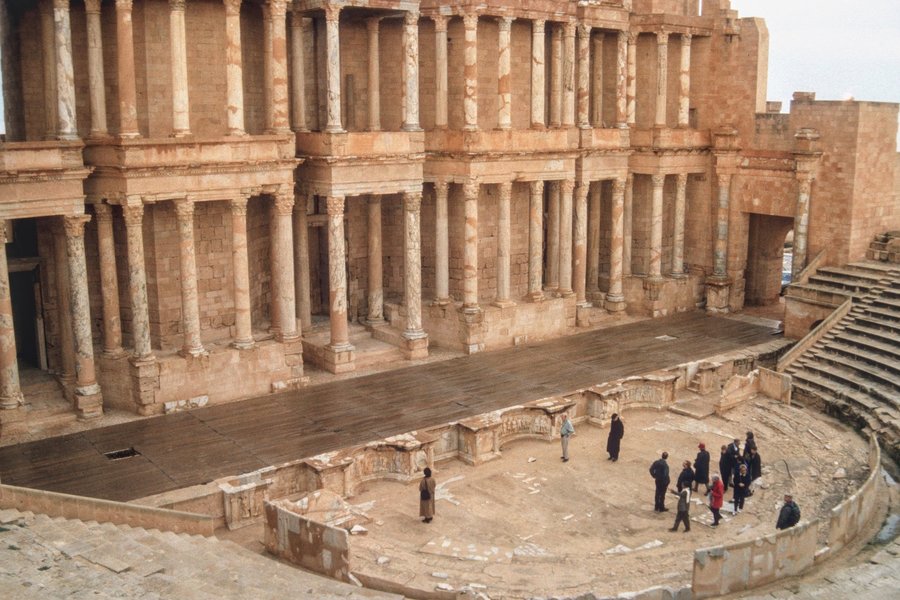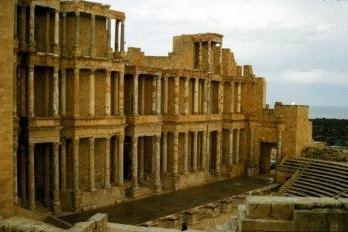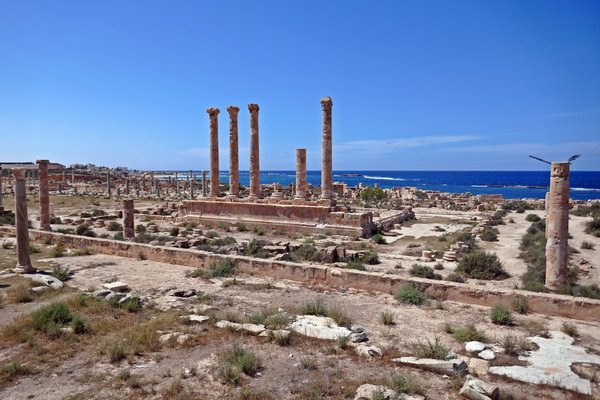Libya
Sabratha
The Archaeological Site of Sabratha comprises an originally Phoenician coastal trading post that was remodeled during its time as a Roman colony.
After the Punic Wars, Sabratha became incorporated in the Roman Province of Africa under Julius Caesar. This brought new prosperity, resulting in the construction of public monuments such as the Forum, the Temple of Jupiter and the Theatre. There is also a Christian basilica with remains of mosaic floors.
Community Perspective: not as large as the Leptis Magna site, and its well-preserved Roman theatre is its main attraction.
Site Info
Official Information
- Full Name
- Archaeological Site of Sabratha (ID: 184)
- Country
- Libya
- Status
-
Inscribed 1982
Site history
History of Sabratha
- 2016: In Danger
- Simultaneously with the four other World Heritage sites of Libya "because of damage caused by the conflict affecting the country and the threat of further damage it poses".
- 1982: Inscribed
- Inscribed
- In Danger
- Simultaneously with the four other World Heritage sites of Libya "because of damage caused by the conflict affecting the country and the threat of further damage it poses". Since 2016
- Type
- Cultural
- Criteria
- iii
Links
- UNESCO
- whc.unesco.org
- Official
-
- temehu.com — Sabratha
- Related
-
- jorgetutor.com — Link
- jorgetutor.com — Link
- en.wikipedia.org — Link
All Links
UNESCO.org
- whc.unesco.org — whc.unesco.org/
Official Website
- temehu.com — Sabratha
Related Resources
- jorgetutor.com — Link
- jorgetutor.com — Link
- en.wikipedia.org — Link
News Article
- March 21, 2023 africa.com — Graffiti Now Covers the Walls of Sabratha
- Sept. 22, 2017 whc.unesco.org — UNESCO’s Director General calls on all parties to cease violence and to protect Sabratha
- Dec. 11, 2015 dailymail.co.uk — Fears are mounting that Islamic State terrorists could destroy Sabratha
Community Information
- Community Category
- Archaeological site: Phoenician
Travel Information
Red Zone Travel Advisory
Recent Connections
-
Red Zone Travel Advisory
Libya fully off-limits -
Built in the 2nd century
Absorbed by Rome in 46AD and "enjoyed i… -
Theatres and Opera Houses
Roman theatre
Connections of Sabratha
- Geography
-
-
Mediterranean shore
-
Under control of ISIS
Since Dec 10, 2015. They have been ousted by "a combination of US airstrikes and attacks by local forces" in February/March 2016.
-
- History
-
-
Phoenician world
Founded as a Phoenician trading-post ca. 500 BC
-
- Architecture
- Damaged
- World Heritage Process
-
-
Perfect Inscriptions
1982 -
Inscribed on a single criterion only
iii. to bear a unique or at least exceptional testimony to a cultural tradition or to a civilization which is living or which has disappeared
-
- Human Activity
- Constructions
-
-
Theatres and Opera Houses
Roman theatre
-
- Timeline
-
-
Built in the 2nd century
Absorbed by Rome in 46AD and "enjoyed its greatest prosperity in the 2nd and 3rd centuries. This was the period which saw the construction of grandiose monuments" (AB)
-
- Visiting conditions
-
-
Red Zone Travel Advisory
Libya fully off-limits
-
News
- africa.com 03/21/2023
- Graffiti Now Covers the Walls of S…
- whc.unesco.org 09/22/2017
- UNESCO’s Director General calls on…
- dailymail.co.uk 12/11/2015
- Fears are mounting that Islamic St…
Recent Visitors
Visitors of Sabratha
- Alexander Barabanov
- Ali Zingstra
- A. Mehmet Haksever
- Ammon Watkins
- Artur Anuszewski
- Christian Wagner
- Eric Lurio
- Eva Kisgyorgy
- Grzegorz Andruszkiewicz
- Harry Mitsidis
- henryjiao18
- Iain Jackson
- Janos
- Kasper
- Krijn
- MarcoB_0
- Marcobrey
- Martin
- Michael Novins
- Patrik_globe
- pete_simms
- pressdm
- RobRos
- Roger Ourset
- Sergio Arjona
- Solivagant
- Szucs Tamas
- Thomas Buechler
- Timothy C Easton
- Vanessa Buechler
- Westwards
- Wo_ko
Community Reviews
Show full reviews
The deep blues and greens of the Mediterranean and clear blue sky create a breathtaking backdrop for this awesome ancient Roman site. I couldn't help but spread my arms wide for applause as I stood on the theatre stage, and lounge on the steps of the classic Roman bath. Even the marble latrines lured me to take a seat and imagine what life there may have been like.
For about $2, I explored, touched, and experienced a past that I had only read about in a History book. I have been to Sabratha twice, and plan to visit again for the wonderful way my mind opens up to the past with wonder and imagination.
Sabratha is not as large as the Leptis Magna site about 3 hours drive to the east, but definately worth seeing. Each site is unique and beautiful, so I recommend taking time to visit both, preferably Sabratha first as it will take your breath away, then allow Leptis Magna to take your breath yet again when you discover the immense size of the preserved city.
Keep reading 0 comments
when I was ten years old, my father was stationed at Wheelus Air Force Base, our family visited the ruins. My sisters and I, were down by the ocean, and I found lying on the ground, a wrapped paper object, with three coins inside. Two coins were smaller ones, about the size of a dime, with nothing on them.
The larger one, was made from brass, with a roman emperor, roman numerals, and perhaps the name of "claudius" on the front. Also on the back, is a standing lady, holding a quiver of arrows, (the goddess "Athena"?), and it's about the size of a silver dollar, and three times as thick.
Keep reading 0 comments
The main glory of Sabratha lies in its well preserved Roman theatre (photo). The site as a whole is not as extensive or fine as that of Leptis Magna and if you are not really into Roman ruins you might even question whether it is worth it. While you are in the region, however, you might as well persevere with these 2 sites, together with the Museum of Tripoli which contains many fine mosaics removed from them (those left in situ are often deteriorating rapidly). Sabratha is pleasantly situated close to the sea. Unfortunately the weather was not so good when we were there – it does rain in Libya! Also it was Ramadan so perhaps we were a bit lacking in sustenance needed to generate real enthusiasm as we walked around unfed - on the journey back to Tripoli we joined the “Ramadan Rush hour” with everyone speeding to get back home before the muezzins announced that it was time to eat and we could join them!
Keep reading 0 comments
